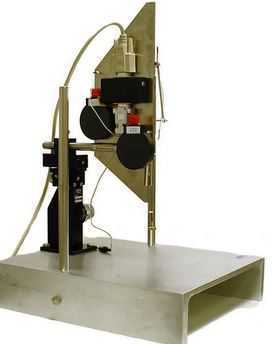
脊髓冲击损伤模型仪MASCIS Impactor ModelⅡ NYU Impactor打击器
产品名称: 脊髓冲击损伤模型仪MASCIS Impactor ModelⅡ NYU Impactor打击器
英文名称:
产品编号: Impactor ModelⅡ
产品价格: 0
产品产地: 美国
品牌商标: NYU
更新时间: null
使用范围: null
- 联系人 :
- 地址 : 中国上海上海上海市
- 邮编 : 201112
- 所在区域 : 上海
- 电话 : 180****9478
- 传真 :
- 邮箱 : brightzhou@micoforce.com
NYU Impactor ModelⅡ MASCIS Impactor, NYU Impactor)脊髓损伤动物模型打击器Multicenter Animal Spinal Cord Injury Study是设计用来为大小鼠施加可重复的标准脊椎撞击。已经开发应用超过十年,它是啮齿类动物脊髓损伤模型的一部分,已经有超过100个实验室在使用它。另外,最近超过50%的关于脊髓损伤研究文献使用的是MASCIS撞击器。大部分仪器的建议操作程序是源自于Multicenter Animal Spinal Cord Injury Study(MASCIS)模型和实际工作经验。 现有MASCIS撞击器现在是它的第三代产品,与以前的产品相比已经有很多方面的改进提高。现有两个型号的撞击器。电脑版撞击器可以记录数据。同时也可以使用基本版撞击器(The Rutgers Impactor)仅进行撞击, 不记录数据。 电脑版撞击器可以精确测量一个10克的小棒的运动情况,这个小棒从12.5mm,25mm,50mm高处落到术后暴露的脊髓T9-10处。另外设备还可以测量撞击位置脊柱的运动。显示坠落小棒的轨迹,并测量撞击速度(ImpV),脊髓压缩距离(Cd),脊髓压缩时间(Ct),脊髓压缩率(Cr)。这些撞击参数本身是相关的,同时与其它的脊髓损伤数值如组织Na,K浓度,运动恢复locomotor recovery(BBB 评分)也是相关的. The MASCIS Impactor is a device designed to deliver graded reproducible spinal cord contusions in rats. Developed over ten years ago, the Impactor is part of a well-defined rodent spinal cord injury model that is used in over 100 laboratories around the world. In addition, more than 50% of recent publications on spinal cord injury research used the MASCIS Impactor. Most of the recommended procedures for the Impactor are based on experience with the model and work done by the Multicenter Animal Spinal Cord Injury Study (MASCIS). The Impactor is now in its third generation with many improvements over previous models. It is available in a model with data recording capability (description and picture links) which requires a Pentium computer. It is also available in a basic model (The Rutgers Impactor) which only does the impact, not the recording of data. Clamping systems are available for both rat and mouse. A clamping system is necessary for the Rutgers basic model and serves as a functional enhancement for the MASCIS model. (description and picture.) When using a clamping system with the MASCIS model, a CS-tie device also is needed. The MASCIS Impactor, formerly called the NYU Impactor, was developed in 1991 by Drs. John Gruner, Carl Mason, and Wise Young. It is now used in laboratories throughout the world in their spinal cord injury studies. The device precisely measures the movement of a 10-gram rod dropped 12.5, 25.0, or 50.0 mm onto the T9-10 spinal cord exposed by laminectomy. In addition, the device measures movement of the spinal column at the impact site, displays the trajectory of the falling rod, and measures the impact velocity (ImpV), cord compression distance (Cd), cord compression time (Ct), and cord compression rate (Cr). These impact parameters correlate with each other and spinal cord lesion volumes (estimated from tissue Na and K concentrations) and locomotor recovery (BBB scores). 1:Serial changes in bladder, locomotion, and levels of neurotrophic factors in rats with spinal cord contusion. Hyun JK, Lee YI, Son YJ, Park JS. Department of Rehabilitation Medicine, Dankook University, Cheonan, Korea. rhhyun@dankook.ac.kr 2:A re-assessment of minocycline as a neuroprotective agent in a rat spinal cord contusion model. Pinzon A, Marcillo A, Quintana A, Stamler S, Bunge MB, Bramlett HM, Dietrich WD. Brain Res. 2008 Dec 3;1243:146-51. Epub 2008 Sep 24. 3 :The role of cation-dependent chloride transporters in neuropathic pain following spinal cord injury. Cramer SW, Baggott C, Cain J, Tilghman J, Allcock B, Miranpuri G, Rajpal S, Sun D, Resnick D. Mol Pain. 2008 Sep 17;4:36. 4:Novel combination strategies to repair the injured mammalian spinal cord. Bunge MB. J Spinal Cord Med. 2008;31(3):262-9. Review. 5:A re-assessment of erythropoietin as a neuroprotective agent following rat spinal cord compression or contusion injury. Pinzon A, Marcillo A, Pabon D, Bramlett HM, Bunge MB, Dietrich WD. Exp Neurol. 2008 Sep;213(1):129-36. Epub 2008 Jul 14. 6: B1 and TRPV-1 receptor genes and their relationship to hyperalgesia following spinal cord injury. DomBourian MG, Turner NA, Gerovac TA, Vemuganti R, Miranpuri GS, Türeyen K, Satriotomo I, Miletic V, Resnick DK. Spine. 2006 Nov 15;31(24):2778-82. 7:Endothelial cell loss is not a major cause of neuronal and glial cell death following contusion injury of the spinal cord. Casella GT, Bunge MB, Wood PM. Exp Neurol. 2006 Nov;202(1):8-20. Epub 2006 Jul 26. 8:Recovery of function following grafting of human bone marrow-derived stromal cells into the injured spinal cord. Himes BT, Neuhuber B, Coleman C, Kushner R, Swanger SA, Kopen GC, Wagner J, Shumsky JS, Fischer I. Neurorehabil Neural Repair. 2006 Jun;20(2):278-96. 9:Mechanical and cold allodynia in a rat spinal cord contusion model. Yoon YW, Dong H, Arends JJ, Jacquin MF. Somatosens Mot Res. 2004 Mar;21(1):25-31. 10:Spinal cord contusion models. Young W. Prog Brain Res. 2002;137:231-55. Review.
